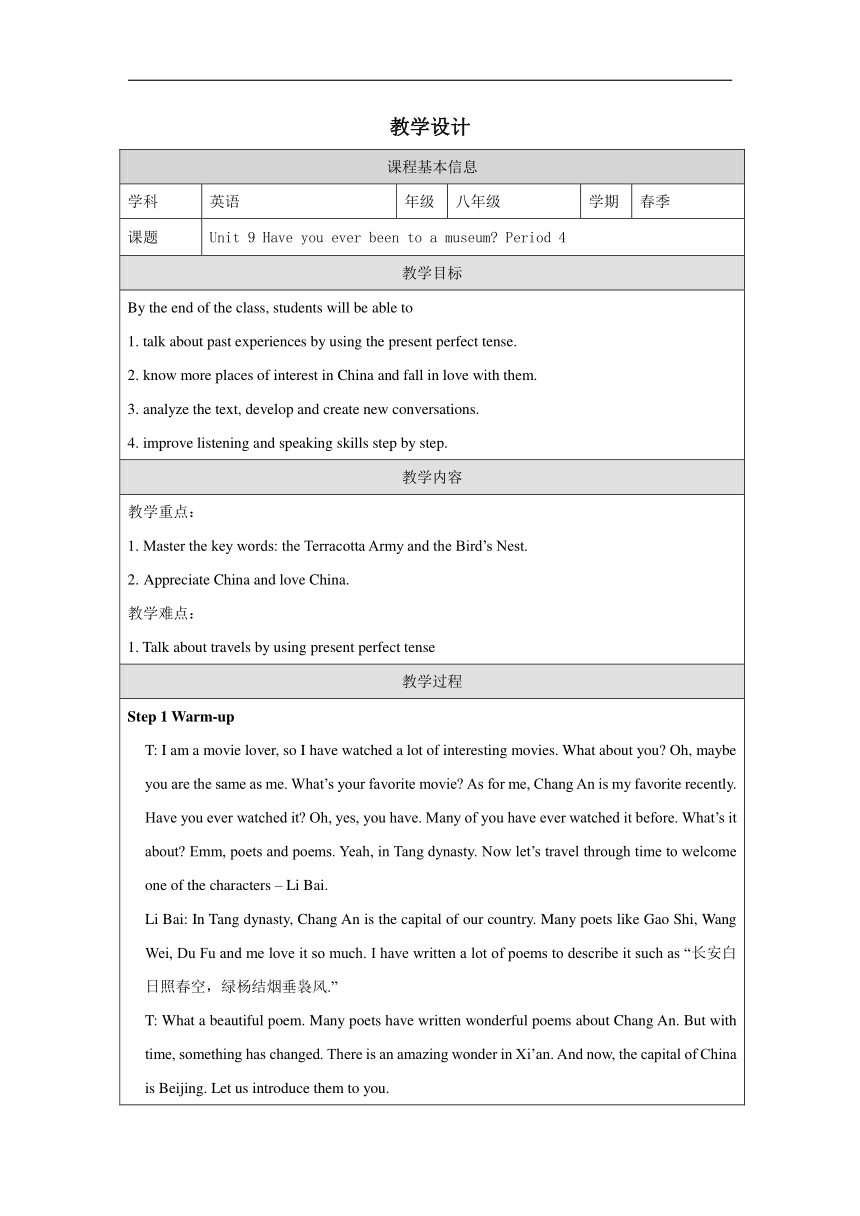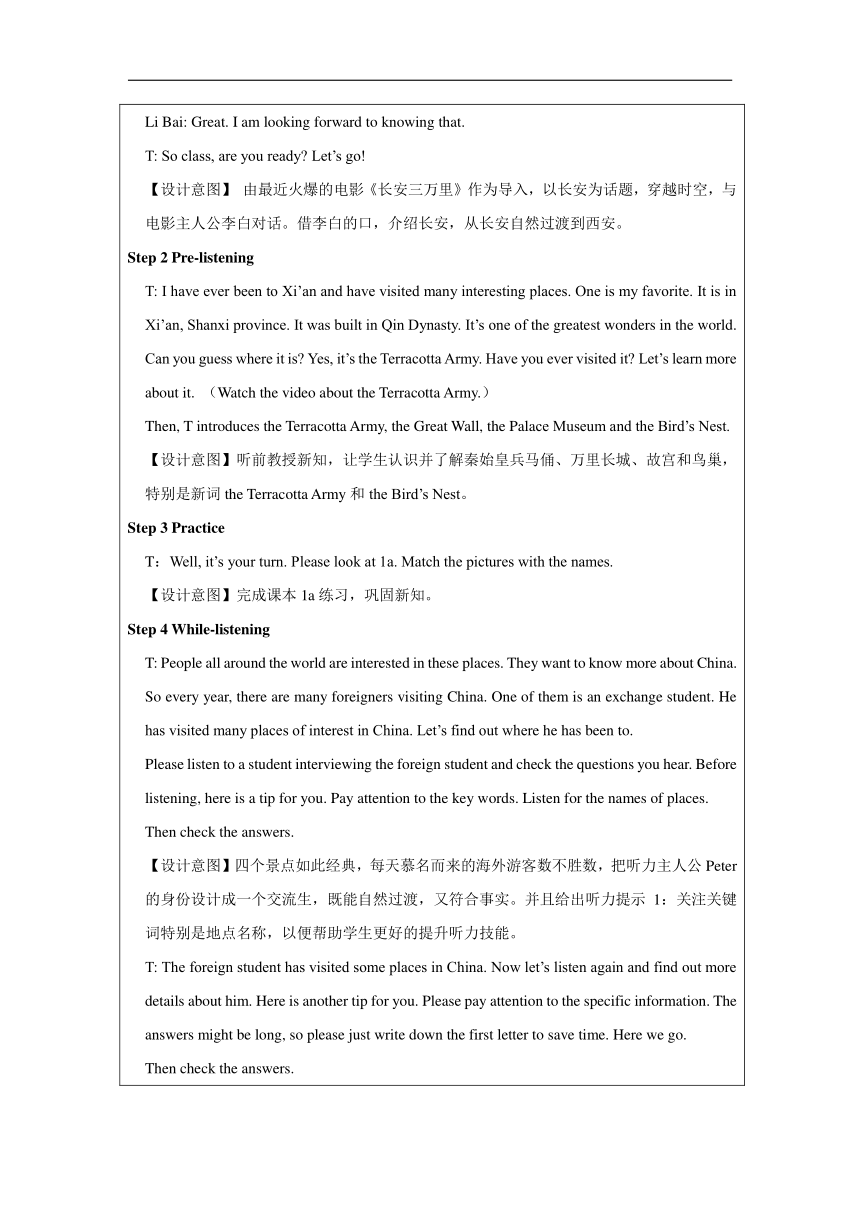人教版八年级下册Unit 9 Have you ever been to a museum Section B 1a—1d 教学设计(表格式)
文档属性
| 名称 | 人教版八年级下册Unit 9 Have you ever been to a museum Section B 1a—1d 教学设计(表格式) |  | |
| 格式 | docx | ||
| 文件大小 | 67.5KB | ||
| 资源类型 | 教案 | ||
| 版本资源 | 人教新目标(Go for it)版 | ||
| 科目 | 英语 | ||
| 更新时间 | 2024-05-08 19:01:41 | ||
图片预览


文档简介
教学设计
课程基本信息
学科 英语 年级 八年级 学期 春季
课题 Unit 9 Have you ever been to a museum Period 4
教学目标
By the end of the class, students will be able to 1. talk about past experiences by using the present perfect tense. 2. know more places of interest in China and fall in love with them. 3. analyze the text, develop and create new conversations. 4. improve listening and speaking skills step by step.
教学内容
教学重点: 1. Master the key words: the Terracotta Army and the Bird’s Nest.
2. Appreciate China and love China.
教学难点: 1. Talk about travels by using present perfect tense
教学过程
Step 1 Warm-up T: I am a movie lover, so I have watched a lot of interesting movies. What about you Oh, maybe you are the same as me. What’s your favorite movie As for me, Chang An is my favorite recently. Have you ever watched it Oh, yes, you have. Many of you have ever watched it before. What’s it about Emm, poets and poems. Yeah, in Tang dynasty. Now let’s travel through time to welcome one of the characters – Li Bai. Li Bai: In Tang dynasty, Chang An is the capital of our country. Many poets like Gao Shi, Wang Wei, Du Fu and me love it so much. I have written a lot of poems to describe it such as “长安白日照春空,绿杨结烟垂袅风.” T: What a beautiful poem. Many poets have written wonderful poems about Chang An. But with time, something has changed. There is an amazing wonder in Xi’an. And now, the capital of China is Beijing. Let us introduce them to you. Li Bai: Great. I am looking forward to knowing that. T: So class, are you ready Let’s go! 【设计意图】 由最近火爆的电影《长安三万里》作为导入,以长安为话题,穿越时空,与电影主人公李白对话。借李白的口,介绍长安,从长安自然过渡到西安。 Step 2 Pre-listening T: I have ever been to Xi’an and have visited many interesting places. One is my favorite. It is in Xi’an, Shanxi province. It was built in Qin Dynasty. It’s one of the greatest wonders in the world. Can you guess where it is Yes, it’s the Terracotta Army. Have you ever visited it Let’s learn more about it. (Watch the video about the Terracotta Army.) Then, T introduces the Terracotta Army, the Great Wall, the Palace Museum and the Bird’s Nest. 【设计意图】听前教授新知,让学生认识并了解秦始皇兵马俑、万里长城、故宫和鸟巢,特别是新词the Terracotta Army和the Bird’s Nest。 Step 3 Practice T:Well, it’s your turn. Please look at 1a. Match the pictures with the names. 【设计意图】完成课本1a练习,巩固新知。 Step 4 While-listening T: People all around the world are interested in these places. They want to know more about China. So every year, there are many foreigners visiting China. One of them is an exchange student. He has visited many places of interest in China. Let’s find out where he has been to. Please listen to a student interviewing the foreign student and check the questions you hear. Before listening, here is a tip for you. Pay attention to the key words. Listen for the names of places. Then check the answers. 【设计意图】四个景点如此经典,每天慕名而来的海外游客数不胜数,把听力主人公Peter的身份设计成一个交流生,既能自然过渡,又符合事实。并且给出听力提示1:关注关键词特别是地点名称,以便帮助学生更好的提升听力技能。 T: The foreign student has visited some places in China. Now let’s listen again and find out more details about him. Here is another tip for you. Please pay attention to the specific information. The answers might be long, so please just write down the first letter to save time. Here we go. Then check the answers. 【设计意图】再听一遍,得到关于Peter的个人信息,完成表格。同时,在听前给出听力提示2:长篇需要写答案的题往往可以简写,以写首字母的方式节约时间,帮助学生更好地完成练习,达到练习听力技巧的目的,提高学生的学习语言能力和学习能力。 T: Let’s come into their conversation. 【设计意图】文本分析,将听力文本分为三个部分,第一部分beginning(Australia-China)用现在完成时谈论去过的地方,第二部分development用现在完成时描述看过的风景和尝过的美味,最后部分ending(China-Australia)留存的念想。同时在第二部分development强调重音stress和语音语调tone,让学生模仿练习,体会听力的魅力。 语言知识包括语音、词汇、语法、语篇和语用知识。语言依靠语音实现其社会交际功能。教师应设计多样的实践活动,引导学生进一步体验、感知、模仿英语的发音,注意重音、语音语调等。更要引导其借助语音知识有效地理解说话人的态度、意图和情感、同时表达自己想要传递的意图、观点和态度,提高学生的学习能力。 Step 5 After-listening T: When we talk about travels, what tenses can we use Yes, have or has plus p.p. past participle. That’s the present perfect tense. For example, we could use I have been to…/I have visited…/I have seen… to talk about the places. Or use I have tried to talk about food. If we want to describe something, the simple past tense may be helpful. Do you think so Emm, yes. You agree with me. What’s more, we could also talk about other things like people, time, weather and so on. For example, Li Bai has met a friendly boy when he is traveling. T: Wow, in the video, Li Bai has been to Du Fu’s hometown Xiangyang. How about you What places have you been to Please talk with your partner. Pay attention to the stress, tone and feelings. T shows an example and let students give scores according to the checklist. 【设计意图】再次借由李白的嘴,让他和杜甫作为一个例子来操练本节课的核心句子,收尾呼应,环环相扣。既能让学生感到新意,又能让学生更好地理解如何使用现在完成时来谈论旅行经历。给出checklist,让学生能更具针对性的练习和创造对话,提高学生的思维品质。 Step 6 Homework T: We know China is a great and beautiful country. She creates many wonders. So, class, Let’s appreciate her and love her. T: Here comes your homework. Students of Level 1, please talk about your travel to your friends. And students of level 2, try to make a short traveling video to introduce your experience by using the present perfect tense. 【设计意图】融合课程思政内容,中国有那么多美丽的景色,我们应该懂得欣赏,也应该更爱这伟大秀丽的祖国,提升学生的文化意识,增强学生的爱国情怀。
课程基本信息
学科 英语 年级 八年级 学期 春季
课题 Unit 9 Have you ever been to a museum Period 4
教学目标
By the end of the class, students will be able to 1. talk about past experiences by using the present perfect tense. 2. know more places of interest in China and fall in love with them. 3. analyze the text, develop and create new conversations. 4. improve listening and speaking skills step by step.
教学内容
教学重点: 1. Master the key words: the Terracotta Army and the Bird’s Nest.
2. Appreciate China and love China.
教学难点: 1. Talk about travels by using present perfect tense
教学过程
Step 1 Warm-up T: I am a movie lover, so I have watched a lot of interesting movies. What about you Oh, maybe you are the same as me. What’s your favorite movie As for me, Chang An is my favorite recently. Have you ever watched it Oh, yes, you have. Many of you have ever watched it before. What’s it about Emm, poets and poems. Yeah, in Tang dynasty. Now let’s travel through time to welcome one of the characters – Li Bai. Li Bai: In Tang dynasty, Chang An is the capital of our country. Many poets like Gao Shi, Wang Wei, Du Fu and me love it so much. I have written a lot of poems to describe it such as “长安白日照春空,绿杨结烟垂袅风.” T: What a beautiful poem. Many poets have written wonderful poems about Chang An. But with time, something has changed. There is an amazing wonder in Xi’an. And now, the capital of China is Beijing. Let us introduce them to you. Li Bai: Great. I am looking forward to knowing that. T: So class, are you ready Let’s go! 【设计意图】 由最近火爆的电影《长安三万里》作为导入,以长安为话题,穿越时空,与电影主人公李白对话。借李白的口,介绍长安,从长安自然过渡到西安。 Step 2 Pre-listening T: I have ever been to Xi’an and have visited many interesting places. One is my favorite. It is in Xi’an, Shanxi province. It was built in Qin Dynasty. It’s one of the greatest wonders in the world. Can you guess where it is Yes, it’s the Terracotta Army. Have you ever visited it Let’s learn more about it. (Watch the video about the Terracotta Army.) Then, T introduces the Terracotta Army, the Great Wall, the Palace Museum and the Bird’s Nest. 【设计意图】听前教授新知,让学生认识并了解秦始皇兵马俑、万里长城、故宫和鸟巢,特别是新词the Terracotta Army和the Bird’s Nest。 Step 3 Practice T:Well, it’s your turn. Please look at 1a. Match the pictures with the names. 【设计意图】完成课本1a练习,巩固新知。 Step 4 While-listening T: People all around the world are interested in these places. They want to know more about China. So every year, there are many foreigners visiting China. One of them is an exchange student. He has visited many places of interest in China. Let’s find out where he has been to. Please listen to a student interviewing the foreign student and check the questions you hear. Before listening, here is a tip for you. Pay attention to the key words. Listen for the names of places. Then check the answers. 【设计意图】四个景点如此经典,每天慕名而来的海外游客数不胜数,把听力主人公Peter的身份设计成一个交流生,既能自然过渡,又符合事实。并且给出听力提示1:关注关键词特别是地点名称,以便帮助学生更好的提升听力技能。 T: The foreign student has visited some places in China. Now let’s listen again and find out more details about him. Here is another tip for you. Please pay attention to the specific information. The answers might be long, so please just write down the first letter to save time. Here we go. Then check the answers. 【设计意图】再听一遍,得到关于Peter的个人信息,完成表格。同时,在听前给出听力提示2:长篇需要写答案的题往往可以简写,以写首字母的方式节约时间,帮助学生更好地完成练习,达到练习听力技巧的目的,提高学生的学习语言能力和学习能力。 T: Let’s come into their conversation. 【设计意图】文本分析,将听力文本分为三个部分,第一部分beginning(Australia-China)用现在完成时谈论去过的地方,第二部分development用现在完成时描述看过的风景和尝过的美味,最后部分ending(China-Australia)留存的念想。同时在第二部分development强调重音stress和语音语调tone,让学生模仿练习,体会听力的魅力。 语言知识包括语音、词汇、语法、语篇和语用知识。语言依靠语音实现其社会交际功能。教师应设计多样的实践活动,引导学生进一步体验、感知、模仿英语的发音,注意重音、语音语调等。更要引导其借助语音知识有效地理解说话人的态度、意图和情感、同时表达自己想要传递的意图、观点和态度,提高学生的学习能力。 Step 5 After-listening T: When we talk about travels, what tenses can we use Yes, have or has plus p.p. past participle. That’s the present perfect tense. For example, we could use I have been to…/I have visited…/I have seen… to talk about the places. Or use I have tried to talk about food. If we want to describe something, the simple past tense may be helpful. Do you think so Emm, yes. You agree with me. What’s more, we could also talk about other things like people, time, weather and so on. For example, Li Bai has met a friendly boy when he is traveling. T: Wow, in the video, Li Bai has been to Du Fu’s hometown Xiangyang. How about you What places have you been to Please talk with your partner. Pay attention to the stress, tone and feelings. T shows an example and let students give scores according to the checklist. 【设计意图】再次借由李白的嘴,让他和杜甫作为一个例子来操练本节课的核心句子,收尾呼应,环环相扣。既能让学生感到新意,又能让学生更好地理解如何使用现在完成时来谈论旅行经历。给出checklist,让学生能更具针对性的练习和创造对话,提高学生的思维品质。 Step 6 Homework T: We know China is a great and beautiful country. She creates many wonders. So, class, Let’s appreciate her and love her. T: Here comes your homework. Students of Level 1, please talk about your travel to your friends. And students of level 2, try to make a short traveling video to introduce your experience by using the present perfect tense. 【设计意图】融合课程思政内容,中国有那么多美丽的景色,我们应该懂得欣赏,也应该更爱这伟大秀丽的祖国,提升学生的文化意识,增强学生的爱国情怀。
同课章节目录
- Unit 1 What's the matter?
- Section A
- Section B
- Unit 2 I'll help to clean up the city parks.
- Section A
- Section B
- Unit 3 Could you please clean your room?
- Section A
- Section B
- Unit 4 Why don't you talk to your parents?
- Section A
- Section B
- Unit 5 What were you doing when the rainstorm came
- Section A
- Section B
- Review of Units 1-5
- Unit 6 An old man tried to move the mountains.
- Section A
- Section B
- Unit 7 What's the highest mountain in the world?
- Section A
- Section B
- Unit 8 Have you read Treasure Island yet?
- Section A
- Section B
- Unit 9 Have you ever been to a museum?
- Section A
- Section B
- Unit 10 I've had this bike for three years.
- Section A
- Section B
